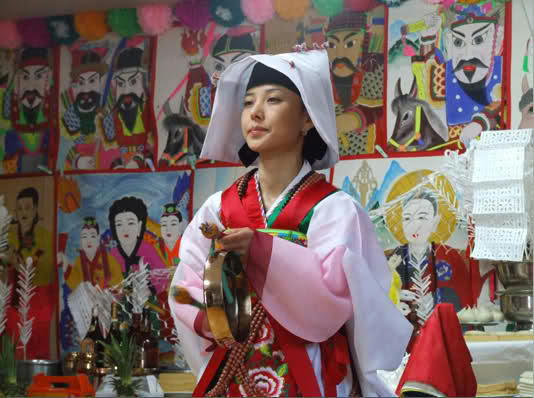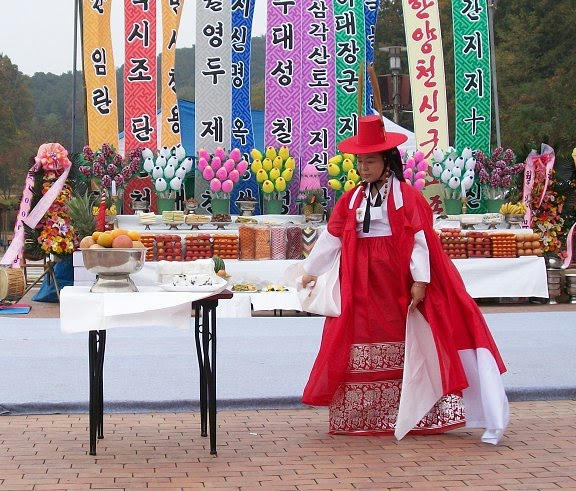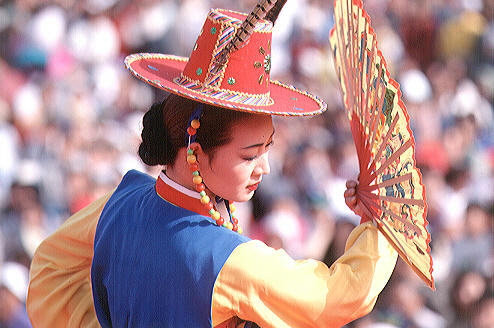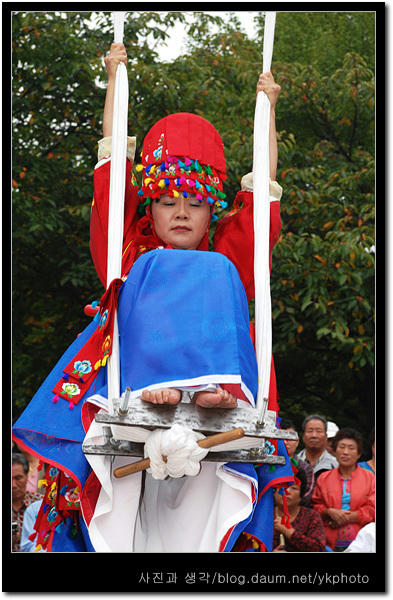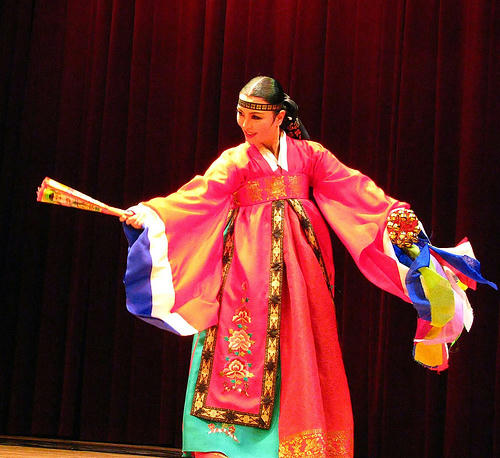I know, the article is
long overdue, and because of some problems and deadlines hanging above me like
sword of Damocles, it's also not that long.
One thing needs to be
stressed out before delving more into fascinating world of shamanism - this is
live tradition in South
Korea, not just folk custom displayed for
tourists, or obscure rites for some initiated elite of practitioners.
To
fully understand the complexity and symbolism of korean shamanism, we must
first take a quick look at eastern shamanism, notably siberian shamanism to
which korean one shows strong links.
In
brief, shamanism is mystic by nature because of the personal voyage of the
shaman who can - through his powers - experience the state of possession or
ecstasy.
Shamanism
has its roots in agriculture rites dating back to the Stone Age, and since then
shaman was fulfilling the role of magician, medicine man, psychopomp and poet.
Not to mention spiritual and often political leader.
Usual
a man (or more likely in Korea
- woman) becomes the shaman during the period known as "arctic
hysteria" or "spiritual sickness". It is the visual proof that
the person was chosen by gods to be the shaman. Usually the first symptoms
appear in early puberty or pre-puberty period and reach their peak in a state
of trance (*digression: spare me psychological crap about linking puberty
and hormonal swing with "spiritual sickness"). During this trance
a shaman leaves his body and in spirit only travels through spiritual worlds
and meets his divine protector (usually in animal form, like bear, wolf, crow
etc.) and when he's back - he's formally dead to the world and reborn.
Precisely, this "reborn" factor is the most important one. During his
journey, shaman climbs mountain or trees. Both mountain and tree symbolize Axis
Mundi - the vertical symbol of world order.
After
shamans' "return", he beomes the only person who can contact and
summon gods, spirits, and also travel to other worlds, be it heaven or hell.
In Korea there
are, however, two types of shamans (called mudang): kangshimmu
and seseummu. Kanghimmu is possessed-type and the latter -
bloodline type. Meaning, the first group experiences shinbyeong
(spiritual sickness, which contrary to northern asian periods, can last for
years), or mubyeong (shaman sickness) the other doesn't. The first group
consist of mainly 2 subgroups: mudang and myeongdu. Mudang
receives god or spirit during the trance and is able to communiate with them,
and myeongdu receives the spirits of dead people. Noteworthy is the
presence of male mudang called baksu. Mainly north of Han
River.
Seseup-mu
are shamans who don't experience "arctic hysteria" and sickness, but
are hereditary shamans and the profession is passed through generations. There
are also two main subgroups to this: shimbang who don't receive
gods/spirits into their bodies but are able to communicate with them through
medium, and dang-ol: perform various rites to serve the gods. Mainly
south of Han River.
The word "mu" was used to signify Korean shamanism long before
Hangeul was invented, and since now there is little clarity on the meaning of
it. Some scholars believe the word "mudang" as the oldest and usual
way of describing the shamans, may derive from Ural-Altaic word
"utagan" or "utakan", however that "M" at the
beginning is a proof this theory lacks solid base (*digression: funny how no
one linked archaic title of Silla kings that is "ma-ripgan" to this
"utagan" theory).
There
are few legends explaining the origins of muism, shamanism in Korea. One is
about "Princess Pari", the seventh daughter of one king who was
thrown out the palace. After six daughters when another girl was born, King got
angry and put the newborn into the stone box (another artifact of korean
mythology!) and cast it in a pond, but she was rescued by the Dragon King. One
day she heard that the king was dying and none of the six princesses wanted to
fetch the medicine water, so she went there, after that was awarded by king.
But according to other legend, princess was thrown out of the palace because
she was insane, so she wandered south of Han River
and one night had a dream that a blue and white crane came to her mouth.
Following mythological logic - she became pregnant and gave birth to four
daughters. Those daughters went to every corner of peninsula giving the start
to mudang tradition.
Most
of the founders (if not all) of Korean kingdoms were also shamans. It is
obvious in case of Jumong who was born in a divine way and after that his
activity was that of a shaman (being a good archer is of course part of it).
Dangun became also a cornerstone for all mudang in Korea. Kings of Silla were shamans
as well, and probably there the notion of divine nature of the King was the
strongest (which, however, didn't stop anyone from staging any coup d'etat,
Koreans never had this weird reverence to any man/woman sitting on the throne).
Kim Suro was powerful shaman who defeated Pak Talhae that challenged his
abilities, and who himself, turns out, was a shaman as well.
Shamanism
existed peacefully (ekhem) until late Goryeo period. In Goryeo, Buddhism became
almost a national religion, which led to abuse of power by monks, and - to some
extend - by shamans. The end of Goryeo is marred by both groups fighting for
power over the court. So when Joseon dynasty came, the law was proclaimed
prohibiting both buddhist temples and shaman activity in the capital. They were
casted out, and we must say that Buddhism never regained much of its pre-Joseon
power (it's an anecdot, but when Japanese monks came to Korea at the
end of 19th century, they were horrified by the poverty in which majority of
the monks lived. Well, it's no secret Japanese Buddhism, on the other hand, is
one of the wealthiest religious orders in the world).
The rite that mudang performs is called gut and there are too much of
them to enumerate, so maybe few the most popular ones:
·
•Naerim gut: initiation rite for new
shamaness.
·
•Dodang gut – performed once in a while,
wish for the well-being and prosperity.
· •Chaesu gut – the most frequently
performed, wish for the luck (it's also the longest and complicated, including
wearing the garb belonging to opposite sex).
·
•Sansang gut – 12-part rite to the
spiritual patron of the community.
·
•Ssitgim gut – purifying rite, sending
off the sould of the dead (often salpuri dance is performed in which
shamaness wears all-white clothes).
The clothes a mudang wears are always bright and colourful, with
majority of them in red, as color red prevents malicious spirits and demons to
stick around. Also, what is interesting in Korean shamanism, mudang wear
also male clothes, especially those of sentinels or guards from Joseon period. This
particular cross-dressing has its practical side - during the gut a male
god or spirit may come and he may refuse to possess a female shaman, but seeing
soldier's uniform - he can be tricked into it. Mudang wear also hats
looking like those of the guards.
Right
now I'm unable to list all costumes of the mudang, because there are
dozens of types and combinations.
One rite must be mentioned though,
it's called 작두 (jakdu) and in Korean the whole expression is
used as 작두를 타다 ("to ride jakdu"). Jakdu
is a razor-sharp blade (or blades) serving as the standing point in some
trance-induced rites. Shaman climbs up on them, and worse - can perform a dance
on those. Jakdu blades are honed just before that. (picture above)
There
is another interesting moment to be mentioned - the pitchfork that shaman
handles and pierces into pig offering. This has its meaning - if this pitchfork
(up to 60cm or 1 m long) stays in its initial position, that means the ritual
was performed right, but if it fells off or something happens to it - it means
the ritual was ill-performed.
Shamanistic elements are found - not a big surprise after all what has been
said here - in Silla crowns, those splendid golden pieces of art and heavy
symbolism.
This is the best known Silla crown from 5th-6th
century. Those vertical shapes with upturned branches (here in the middle)
represent seonang namu, or sindansu, that is Axis Mundi, the cosmical tree. What
we have also are horns (or rather antlers) and wings. Those curved blue beads
are also of shamanistic-provenance.
Korean shamanism influenced dance and performing arts as well, but this is a topic for another, long resentation, I guess. All instruments, ie. used in samulnori come from those used in gut rites. Also, pansori is based on shamanistic rituals, as well as talchum (mask dance).
Why
shamanism is still popular in Korea?
Well, it serves the purpose of answering people's needs. It has always this
characteristic and this is why shamanism was always closer to people than any
other system of belief, because it functions on everyday level. Rites for good
harvest in the past are equal to buying a talisman for good grades. Consulting
the shaman on good day or bad, also on ancestral opinion is still popular now.
Plus, what is worth mentioning, shamanism preserved ancient oral tradition, especially
in shaman songs.
Yes,
shamanistic ritual is noisy, btw.
Sources:
Eliade
M., Shamanism 1974
Lee
J.Y., Concerning the Origin and Formation of Korean Shamanism, Numen,
vol. 20 1973
Pettid
M.J., Shamans, Ghosts and Hobgoblins amidst Korean Folk Customs, SOAS
2009

